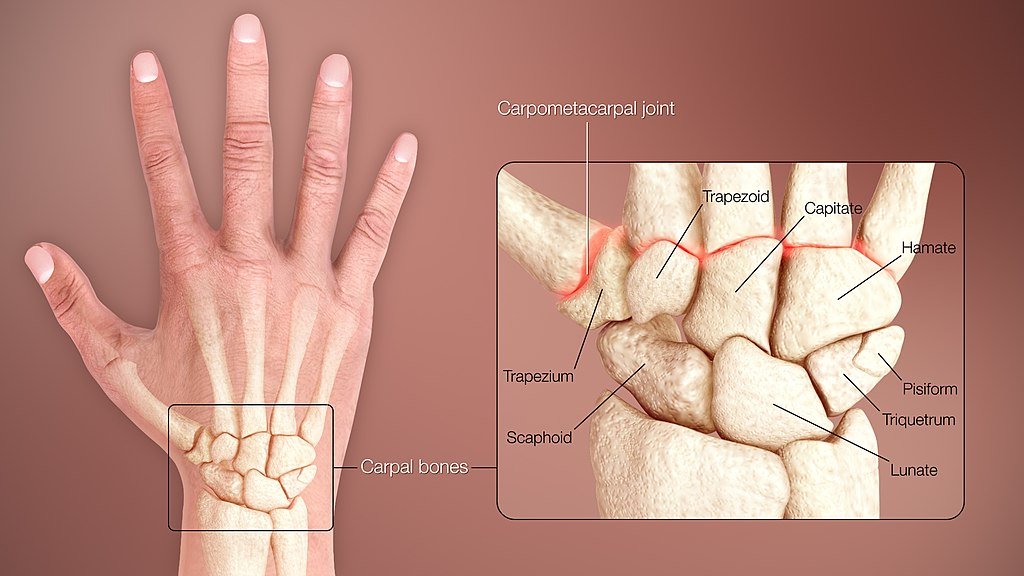Let us talk about wrist pain today. The wrist connects your palms with your forearms. A wrist that is free of injuries helps you to use your hands for various everyday tasks. Your wrist also provides the transit for the nerves, blood vessels, and tendons to enter your palms.
Wrist pain is a common problem that can make your life difficult. It can be due to injuries or health issues with your wrist bones, joints, ligaments, or nerves. One can often manage at home with simple exercises or other measures, but sometimes it does require consultation with your physiotherapist or doctor.
Structure & Function of the Wrist
Your wrist is formed by the union of eight carpal bones, which include the scaphoid, lunate, trapezium, trapezoid, capitate, hamate, triquetrum, and pisiform. The eight carpal bones form two rows. The first row approximates the radius and the ulna (the bones of the forearm). The second row approximates the five metacarpals of the palm.
Yet, these eight carpal bones are arranged so beautifully that they allow movements of your wrist in multiple ways (side-to-side, front, and back). So, your wrist turns out to be both strong and flexible at the same time because of this complex arrangement.
Meanwhile, this complex arrangement of carpal bones also gives enough space to the nerves and blood vessels supplying the hand to pass through safely via a tunnel-shaped structure called the carpal tunnel.

Image Credit: https://www.scientificanimations.com (CC BY-SA 4.0) via Wikimedia Commons
Causes for discomfort in Wrist
Injuries or diseases disturbing this complex structure of the wrist can cause not only pain but also limit the movements of the wrist joint. On top of it, they can also cause compression of the nerves transiting via carpal bones, causing a condition known as carpal tunnel syndrome.
Wrist pain is often due to trauma. Injuries to the wrist are commonly seen after falling on an outstretched hand. Participation in sports also increases the risk of injuries to the wrist. Even more, subtle forms of injuries, like repetitive strain injury also result in wrist pain commonly. This form of injury is often related to occupations that involve the overuse of the wrist or using hand-held tools.
Non-traumatic causes are being seen more commonly with a rise in chronic diseases like diabetes, obesity, and arthritis. Diabetes and obesity increase the risk of carpal tunnel syndrome by causing compression of the nerves of the hand and wrist in the carpal tunnel, resulting in typical spreading pain in the hand. Whereas arthritis or degenerative joint diseases directly damage the wrist joint resulting in pain, swelling, and limitations of wrist movements.
Other causes of wrist pain includes ganglion cysts (soft-tissue cysts) and Kienbock’s disease (degeneration of a carpal bone due to decreased blood supply to it).
Tips for Healthy Wrist
Here are some tips for keeping your wrist healthy:
- Use proper posture and ergonomics when working: Proper posture and ergonomics can help reduce strain on the wrist. This includes keeping your wrist in a neutral position when typing or using a mouse, and taking regular breaks to stretch and rest your wrists.
- Avoid excessive gripping: Gripping objects too tightly can lead to wrist strain. Try to relax your grip when holding objects, and use tools that are designed to reduce gripping effort, such as padded handles or power tools.
- Wear wrist splints: If you have wrist pain or a wrist injury, wearing a wrist splint can help reduce strain on the joint and allow it to heal.
- Avoid activities that put excessive strain on the wrist: Certain activities, such as lifting heavy weights or playing certain sports, can put excessive strain on the wrist. If you participate in these activities, be sure to use proper technique and consider wearing wrist supports to protect the joint.
Exercises for Healthy Wrist
Incorporating wrist exercises into your daily routine can help improve flexibility and strength in the wrist. Here are a few exercises to try:
- Wrist flexion and extension: Place your forearm with palm down on a table and use your other hand to gently bend your wrist up and down. Repeat 10 times on each hand.
- Wrist circles: Place your forearm with palm down on a table and make small circles with your wrist. Repeat 10 times in each direction on each hand.
- Wrist curls: Hold a light dumbbell or can of soup in your hand with your palm facing up. Bend your wrist up and down to curl the weight. Repeat 10 times on each hand.
- Wrist stretches: Hold your arm out straight in front of you with your palm facing down. Gently use your other hand to push your wrist down, stretching the muscles on the top of your wrist. Hold for 30 seconds and repeat on the other side.
By following these tips and incorporating wrist exercises into your routine, you can help keep your wrists healthy and prevent pain and injuries. If you are experiencing persistent or severe wrist pain, it is important to consult with a healthcare professional, such as a physiotherapist, for proper diagnosis and treatment.
When to Consult a Physio for Wrist Pain
In many cases of wrist pain, especially those due to minor trauma, the pain may resolve or get better with self-care using pain relievers, ice packs, rest, etc. Wrist stretching exercises can help regain the movements faster. Similarly, cessation of the movements that aggravate the wrist pain is another way to improve your recovery.
Yet in some cases, self-management may not give adequate relief from wrist pain. It is also possible that though there may be some relief, it is insufficient to carry out your daily activities. Those are some definite reasons to see your doctor or physiotherapist.
There is no harm in seeking professional consultation with a physio if things are not working out as desired. Especially, with the advances in technology and telerehabilitation, a consultation with a physio can be held virtually and need not always require you to travel to their practice.
Even more, if you notice worsening of your pain, swelling, and inability to bear weight through your hands; an urgent assessment by a physio or your doctor may be warranted. A delayed diagnosis or inadequate care in such an event may prolong your pain and suffering and it should be avoided at all costs.
If you reside in British Columbia, Canada, and have wrist pain that needs the attention of a physiotherapist, you can seek a virtual consultation with KBPhysio.ca. Please call us at (778) 658-6949 or email us.
Further Readings
1. National Health Service, UK. https://www.nhs.uk/conditions/hand-pain/wrist-pain/
2. National Library of Medicine, USA https://medlineplus.gov/ency/article/003175.htm
3. Mayo Clinic, USA https://www.mayoclinic.org/diseases-conditions/wrist-pain/symptoms-causes/syc-20366213
